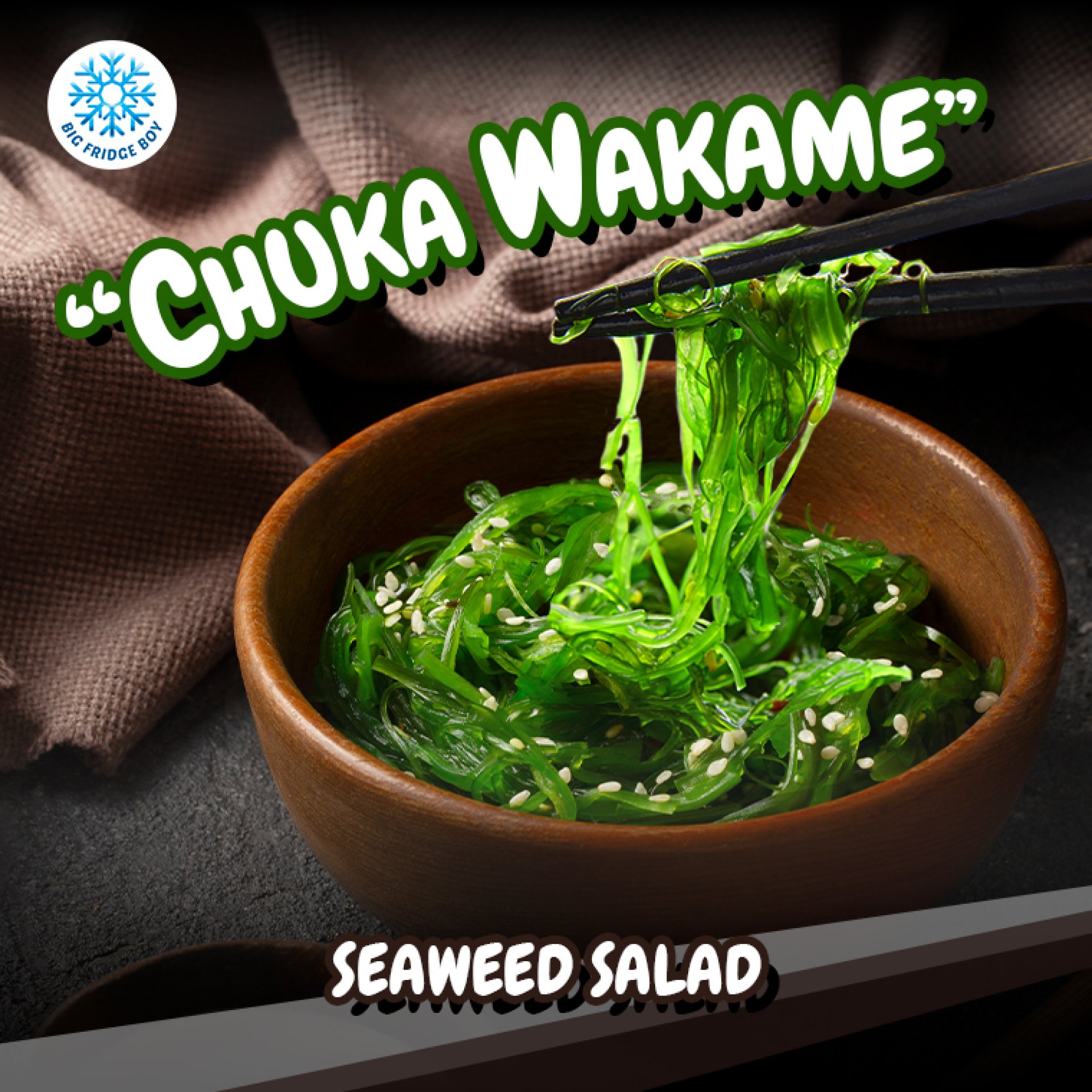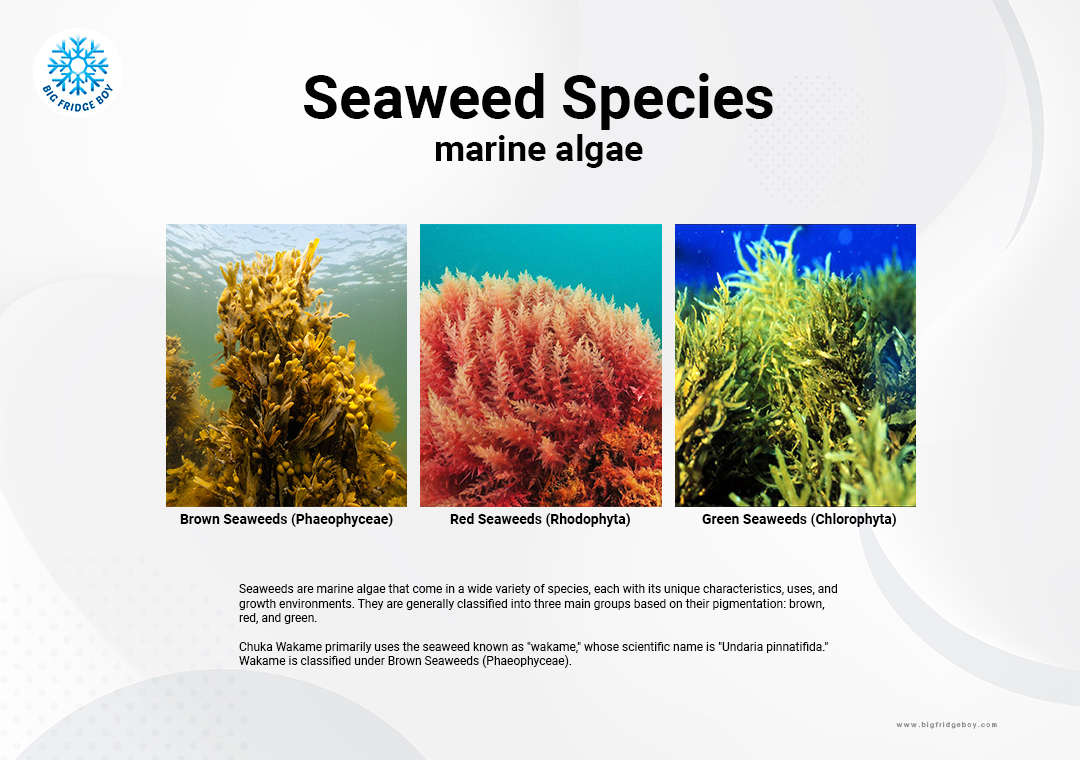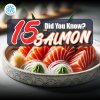"Chuka Wakame" seaweed salad, health lovers can't miss it!!

"Chuka Wakame" is a popular seaweed salad often found in Japanese cuisine. The term "Chuka" is derived from "Chūka," which means "Chinese" in Japanese. This indicates that the dish has Chinese origins but has been adapted and become popular in Japanese cuisine.

Seaweeds are marine algae that come in a wide variety of species, each with its unique characteristics, uses, and growth environments. They are generally classified into three main groups based on their pigmentation: brown, red, and green. Here are some notable species from each category:
Brown Seaweeds (Phaeophyceae):
- Kelp: This is a large type of seaweed that can form underwater kelp forests, providing vital habitats for various marine organisms. Species like "Macrocystis pyrifera" are well-known kelps.
- Fucus: Also known as rockweed or bladderwrack, species like "Fucus vesiculosus" are commonly found in intertidal zones.
- Sargassum: These are seaweeds that are sometimes found floating in large quantities, particularly in the Sargasso Sea.
Red Seaweeds (Rhodophyta):
- Nori: Scientifically known as "Porphyra" or "Pyropia", this seaweed is commonly used to wrap sushi rolls.
- Dulse: Known scientifically as "Palmaria palmata", dulse is a red seaweed that's often eaten dried or fresh.
- Irish Moss: "Chondrus crispus" is a species of red algae that's used as a source of carrageenan, a thickening agent.
Green Seaweeds (Chlorophyta):
- Sea Lettuce: This seaweed, known scientifically as "Ulva lactuca", resembles lettuce leaves and is sometimes used in salads or soups.
- Caulerpa: This is a genus of seaweed that comes in various shapes and sizes. Some species, like "Caulerpa lentillifera", are popular in Asian cuisines and are known as sea grapes or green caviar.
- Enteromorpha: These are tubular green seaweeds that can be found in various marine environments.
Chuka Wakame primarily uses the seaweed known as "wakame," whose scientific name is "Undaria pinnatifida." Wakame is classified under Brown Seaweeds (Phaeophyceae).
Origin
- Chinese Origins:
The name "Chuka" signifies Chinese-style dishes in Japan. Many Chuka dishes were introduced to Japan primarily in the late 19th and early 20th centuries. The techniques and flavorings in Chuka Wakame resemble those in certain Chinese cold dishes, which often feature a mix of sweet, sour, and savory seasonings. - Introduction to Japan:
As trade and cultural exchanges between China and Japan increased, many Chinese dishes were adapted to Japanese tastes. Over time, dishes like Chuka Wakame became integral to Japanese cuisine, especially within certain dining contexts like izakaya (Japanese gastropubs) and sushi restaurants. - Modern Popularity:
The modern global sushi boom has further popularized Chuka Wakame. As sushi restaurants spread worldwide, many also started serving Chuka Wakame as an appetizer or side dish, making it recognizable to many people, even outside of Japan. - Adaptation and Variations:
While the base of Chuka Wakame remains wakame seaweed, there are regional and individual variations in seasoning and additional ingredients. Some might add ingredients like sesame seeds, red pepper flakes, or other types of seaweeds and vegetables.
Chuka Wakame is a testament to the fluidity of culinary traditions and how dishes can evolve and integrate into the cuisines of other cultures. It embodies a fusion of Chinese seasonings and techniques with Japanese taste preferences, subsequently achieving global recognition due to the international popularity of sushi restaurants.
The production of "Chuka Wakame," a popular seaweed salad in Japanese cuisine, involves several steps to achieve its unique flavor and texture:
- Seaweed Selection: The process begins with the selection of high-quality, fresh Wakame seaweed (Undaria pinnatifida), a brown marine algae.
- Cleaning and Preparing the Seaweed: The harvested seaweed is washed to remove sand, salt, and other impurities. It may then be trimmed to obtain the best parts for the salad.
- Blanching or Boiling: After cleaning, the seaweed is blanched or boiled to soften its texture and enhance its taste. This step also helps to sterilize the seaweed, eliminating potential pathogens.
- Seasoning: The prepared seaweed is seasoned with a mixture that gives Chuka Wakame its distinctive flavor, such as sugar, vinegar, soy sauce, and sesame oil. Additional ingredients like sesame seeds, chili flakes, or extra sweeteners may also be added.
- Marinating: After seasoning, the seaweed may be marinated to deepen its flavors. The duration of marination can vary depending on the recipe or production method.
- Cooling and Packaging: The seasoned seaweed is then cooled or refrigerated to preserve its freshness and taste. It is packaged in appropriate containers, often plastic bags or sealed containers, to prevent contamination and maintain quality.
- Storage and Distribution: The packaged seaweed salad is stored under suitable conditions until it is distributed to stores, restaurants, or directly to consumers.
The production of Chuka Wakame not only requires an understanding of cooking and marinating techniques but also knowledge about selecting quality seaweed and post-harvest management to preserve the best quality and taste.
Taste
Chuka Wakame, or seaweed salad, has a unique taste that's a combination of the inherent flavor of wakame seaweed and the seasonings used in its preparation. Here's a breakdown of its taste profile:
- Mildly Oceanic: The primary ingredient, wakame seaweed, has a delicate briny taste that can be reminiscent of the ocean. It doesn't have an overpowering "fishy" taste, but rather a subtle, fresh ocean flavor.
- Slightly Sweet: The dressing used in Chuka Wakame often contains a sweetener, which could be sugar or mirin (a sweet rice wine). This gives the salad a hint of sweetness, which balances the other flavors.
- Tangy: Vinegar or citrus juice is also a common ingredient in the dressing, lending a tangy note to the salad.
- Savory: Soy sauce, which provides saltiness and umami, is another key component in many Chuka Wakame dressings.
- Toasted Sesame Undertones: Toasted sesame oil and sometimes sesame seeds are added, which impart a nutty and aromatic quality to the salad.
Chuka Wakame offers a delightful balance of sweet, tangy, salty, and umami flavors with a hint of the ocean, rounded out by the aromatic nuttiness of sesame. The complexity of its taste, combined with its unique texture, makes it a favorite for many who try it.

Nutrition
Chuka Wakame, or seaweed salad, is not only delicious but also nutritious. Wakame, the primary ingredient, is a sea vegetable that has been a part of the East Asian diet for centuries and is known for its health benefits. Here's a breakdown of its nutritional profile:
- Low in Calories: Wakame is naturally low in calories, making it a suitable addition for those watching their calorie intake.
- Rich in Vitamins & Minerals:
- Iodine: One of the most notable minerals in wakame is iodine, essential for proper thyroid function.
- Calcium: Good for bone health.
- Magnesium: Important for various biochemical reactions in the body.
- Folate: Crucial for DNA synthesis and cell division.
- Vitamin K: Important for blood clotting and bone health.
- Iron: Essential for the transportation of oxygen in the blood.
- Iodine: One of the most notable minerals in wakame is iodine, essential for proper thyroid function.
- Dietary Fiber: Wakame contains dietary fibers, which can aid in digestion and promote a feeling of fullness.
- Omega-3 Fatty Acids: While not as high as in some other foods, wakame does contain some omega-3 fatty acids, which are known for their anti-inflammatory properties and potential heart health benefits.
- Fucoidan: This is a unique compound found in brown seaweed like wakame. Preliminary studies have shown it might have anti-inflammatory, antiviral, and anticancer properties.
- Potential Sodium Content: While wakame itself is not high in sodium, the dressings and seasonings used in Chuka Wakame might increase the sodium content. It's always good to be mindful of this, especially if you're watching your salt intake.
- Added Sugars: Some preparations of Chuka Wakame can contain added sugars in the dressing. This can contribute to the overall calorie and carbohydrate content.
Culinary uses
Chuka Wakame, or seaweed salad, is versatile in its culinary uses. While it's commonly consumed as a stand-alone dish, its vibrant color, unique texture, and distinctive flavor make it an excellent complement to various dishes. Here are some popular culinary uses for Chuka Wakame:
- Appetizer: In many sushi restaurants and Japanese dining establishments, Chuka Wakame is often served as a refreshing appetizer before the main course.
- Side Dish: It pairs well with other Japanese dishes like tempura, sashimi, or sushi. Its bright taste can complement richer or heavier dishes, providing a balanced meal experience.
- Poke Bowls: With the increasing popularity of poke bowls, Chuka Wakame can be added as one of the toppings, providing an extra layer of flavor and texture.
- Topping for Rice: Chuka Wakame can be placed on top of a bowl of steamed rice for a simple and nutritious meal.
- Incorporate into Salads: You can mix Chuka Wakame with other salad greens, veggies, and even proteins like tofu or grilled chicken for a unique salad dish.
- Sushi Rolls: Some sushi rolls incorporate Chuka Wakame either inside the roll or as a topping, adding a burst of flavor and a different texture.
- Noodle Dishes: Cold noodle dishes, especially during summer, can benefit from the addition of Chuka Wakame. Its tangy and slightly sweet flavor complements the savory notes of noodle dishes.
- Bento Boxes: Chuka Wakame can be a colorful and tasty addition to bento boxes, providing a balanced variety of flavors and textures in the meal.
- Wraps and Sandwiches: For a twist, you can add Chuka Wakame into wraps or sandwiches, especially those with seafood fillings like shrimp or crab.





